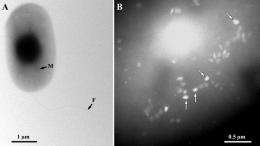New bug eats sulfates, makes two kinds of magnet

(PhysOrg.com) -- A bacterium recently discovered near Death Valley has some very unusual properties according to a report published in the December 23 issue of Science magazine. While some ‘bugs’ are like migratory birds, making tiny magnets that they use to guide their navigation, this is the first bacterium to be found that makes two different kinds of magnetic particles.
The report, “A Cultured Greigite-Producing Magnetotactic Bacterium in a Novel Group of Sulfate-Reducing Bacteria,” describes the first successful attempt to grow the bacterium in the laboratory, opening the door to understanding how it works, and potentially harnessing its tools for manufacturing or environmental cleanup.
Led by University of Nevada Las Vegas microbiologist Dennis Bazylinski, the team includes Ames Laboratory scientist Tanya Prozorov, who performed characterization studies of the cultured bacterium. Bazylinski, formerly an Iowa State University researcher, and his postdoctoral associate, Christopher Lefèvre found the new bacterium, named BW-1, in a basin named Badwater on the edge of Death Valley National Park.
Magnetotactic bacteria, which may be among the oldest organisms on the planet, produce intracellular magnetic nanocrystals, which allow the swimming bacteria to orient along the geomagnetic lines of Earth. Magnetotactic bacteria serve as inspiration and a source of mineralization proteins for room temperature synthesis of magnetite nanocrystals with controlled sizes and morphologies. The isolation of this newly identified organism and the growth, essentially from a single cell, of
the culture, will allow for systematic studies on the largely unknown greigite (Fe3S4) biomineralization in magnetotactic bacteria.
“Typically, bacteria produce either magnetite or greigite, but not both,” Prozorov said, “so these ‘bugs’ are something new. Over several years, our research group has studied many different bacteria using (electron) microscopy with subsequent measurements of their magnetic properties.”
“Clearly, determining the morphology and chemistry of intracellular magnetic nanoparticles is the key to understand their physical properties,” she adds. “ Despite the best effort to produce such nanoparticles in vitro, bacterial nanocrystals are still superior, exhibiting different morphologies including rod and tooth shapes.”
A detailed examination of its DNA revealed that BW-1 has two sets of magnetosome genes unlike other that produce only one mineral and have only one set of magnetosome genes. This suggests that the production of magnetite and greigite in BW-1 is likely controlled by separate sets of genes. This could be important in the mass production of either mineral for specific applications.
Due to a slight difference in physical and magnetic properties, greigite might prove superior to iron oxide in some applications. Greigite is also an important magnetic mineral in the sedimentary record, and is thought to play a significant role in the cycling of iron sulfur in modern, and perhaps ancient environments.
These results might provide the insight on the chemical conditions under which this greigite is formed, and will be of great interest to a broad scientific community, ranging from microbiologists to materials scientists and astrobiologists.
Provided by Ames Laboratory



















